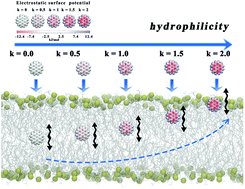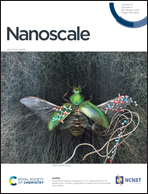The role of electrostatic potential polarization in the translocation of graphene quantum dots across membranes†
Abstract
Graphene quantum dots (GQDs) have shown promising potential applications in the field of biomedicine. To date, understanding the GQD–cell membrane interactions remains a key issue in developing their biomedical applications, such as targeted drug delivery and bio-imaging. In this study, we mainly shed light on the mechanism of how to control the interactions between GQDs and membranes by tuning the electrostatic potential (EP) of GQDs. Charge distributions at the edge sites were adjusted to mimic the modified EP of GQDs, given that the physicochemical properties of GQDs are usually regulated and determined by the grafted groups and doped atoms at edges. We found that the dynamics of GQDs in the GQD–membrane system can be regulated effectively by modulating the EP of GQDs, which is not only determined by the direct GQD–cell interactions but also by the GQD–water interactions. GQDs with non- or less-polarized EP are hydrophobic, and they can easily translocate into the inner membrane from the bulk water because of the decreased GQD–POPC van der Waals interactions and the favorable dehydration process. In the case of a GQD with more polarized EP, the nanomaterial prefers to adsorb onto the membrane surface due to the strong electrostatic attraction between the GQD and lipid headgroups, and especially, the high dehydration free energy of GQDs can even lead to transient detachment from the surface. These findings would be helpful to understand the interactions between GQD-based nanomaterials and cell membranes, facilitating the rational design of GQD-related biomedicines.

- This article is part of the themed collection: Theoretical Modelling at Nano-bio Interfaces


 Please wait while we load your content...
Please wait while we load your content...